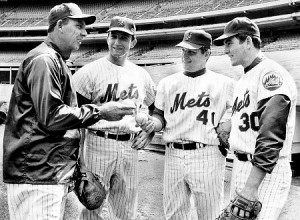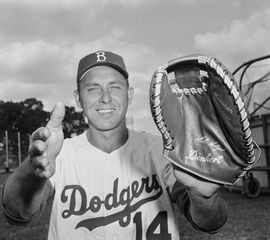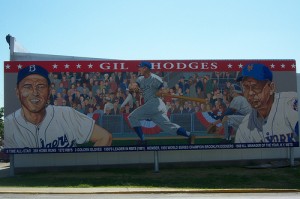Why Isn’t Gil Hodges In The Baseball Hall of Fame?
With a new class set for induction into the Baseball Hall of Fame this weekend, it provides another opportunity to ask the question of why baseball legend Gil Hodges does not have a plaque in Cooperstown.
It is very likely that many longtime baseball fans (and perhaps even some Hall of Fame voters) just assume that Hodges took his rightful place in Cooperstown decades ago. Because he passed away in 1972, Hodges’ omission does not receive the same annual publicity as that of other deserving candidates who are still living.
One of the famed “Boys of Summer” that led the Brooklyn Dodgers to six World Series appearances between 1947 and 1956, Hodges was the starting first baseman in an infield that included Hall of Famers Jackie Robinson at second base and Pee Wee Reese at shortstop.
Along with Duke Snider, Hodges served as a steady power threat and run producer for the Dodgers. Hodges drove in more than 100 runs for seven straight years between 1949 and 1955, including a career-high 130 RBIs in 1954. His 1,001 RBIs in the 1950s were the most in the National League during the decade.
Hodges eclipsed the 30 home run mark six times, including blasting 40 home runs in 1951 and 42 in 1954. He also scored more than 100 runs three times and had a season batting average above .300 twice.
A member of seven World Series teams during his entire tenure with the Brooklyn and Los Angeles Dodgers from 1947 (he did make a brief appearance for the Dodgers in 1943, but because of military service didn’t return to the majors until 1947) through 1961, Hodges often saved his best for the postseason.
After suffering through an abysmal 1952 series in which he didn’t get a hit in 21 at bats, Hodges rebounded to terrorize pitchers during his next four trips to the Fall Classic. In those four series, he hit .337 with four home runs and 16 RBIs. He drove home eight runs in 1956 and hit .391 in 1959.
Also excellent with the glove, Hodges was the recipient of the first three National League Gold Glove awards for first basemen between 1957 and 1959.
After playing a limited role in two seasons back in New York as a member of the expansion Mets, Hodges retired as a player ranking 12th all-time with 370 home runs and 41st with 1,274 RBIs. He still stands 68th in baseball history in home runs and 110th in RBIs. He finished with a .273 career batting average and 1,105 runs scored.

With the help of pitching stars Jerry Koosman, Tom Seaver and Nolan Ryan, Hodges helped lead the Mets to the 1969 World Series title.
Following the end of his playing career, Hodges transitioned immediately into the role of baseball manager. He skippered the Washington Senators for four seasons before taking over the New York Mets in 1968.
In just his second season with the Mets, he led them from their traditional spot in the National League cellar to 100 wins and a surprising division title. After defeating the Atlanta Braves to win the NL Pennant, the “Miracle Mets” shocked the baseball world by defeating the Baltimore Orioles to win the World Series.
He led the Mets to winning seasons in three of his four years with the team before his surprising death from a heart attack just two days before what would have been his 48th birthday.
Given his impressive pedigree as both a player and manager, it seems very surprising that Hodges never earned enough support from the baseball writers to reach the Hall of Fame. He received at least 50% support in 11 of his 15 years on the ballot, but topped out at 63.4% (75% needed for election) during his final year of eligibility.
Though he has been on the ballot for the Veterans Committee for more than 20 years, with each passing year his chances for selection seem to get slimmer.
Even without the Hall of Fame stamp of immortality, Hodges’ still has reached legendary status in some circles.
In a famous scene in the movie “Field of Dreams”, the young Doc Graham marvels at the all-time baseball greats on the field including mentioning Gil Hodges by name. His number was retired by the New York Mets in 1973 and a 52-foot by 16-foot mural of Hodges has been painted in his hometown of Petersburg, Indiana.
Sure there are now players not in the Hall of Fame with better career home run or RBI totals, but no player who is not in the Hall of Fame recorded such steady and impressive offensive production while being such a vital member of a team that was regularly winning and contending for championships.
When combined with his role as manager of the Mets, Gil Hodges seems to be a no-brainer for the Hall of Fame and it is a shame that another year will go by without him receiving the recognition he so richly deserves.


As Mayor for the City off Petersburg, Indiana – great article! For you Hodges fans, prints of the mural are still available and can be purchased by calling Petersburg City Hall at 812-354-8511. Prices are $159 unframed, and $229 framed.
Mayor Jon W. Craig, City of Petersburg, Indiana
Absolutely agree with you Michael Keedy. I've heard that Gil's lifetime batting average of .273 is keeping him out but there are plenty of Hall of Famers who have similar batting averages: Aparicio, Perez, McCovey, Killebrew, Mazeroski, and more recent Hall of Fame inductee Joe Gordon. So why is Gil being passed by?? There is no logical excuse or reason to keep Gil out. It is a huge injustice to a decent man with impeccable character and integrity who would never have sold drugs (Cepeda sold drugs to kids in Puerto Rico yet made the Hall), would never have carried a suitcase full of recreational drugs for his team (HOFer Fergie Jenkins got caught literally holding the bag), or cheated on his wife (HOFer Don Sutton). The way things are now the steroid users like Bobby Bonds and Sammy Sosa, etc will get in the Hall before Gil does!!! The injustice of Gil not being in the Hall really irks me compared to some of the riff-raff the Hall lets in!
The standard amount is often as practices:You 005 billion inside of identify operations,362 billion through commodity combined with Just one 714 million inside of trades very nearly simply found in OTC deals,
I beloved up to you will receive performed proper here. The caricature is attractive, your authored material stylish. nonetheless, you command get bought an nervousness over that you would like be handing over the following. in poor health no doubt come more in the past again as precisely the similar nearly a lot continuously inside of case you shield this hike.
hello!,I love your writing very so much! proportion we be in contact extra approximately your post on AOL? I need an expert in this house to solve my problem. Maybe that’s you! Looking ahead to look you.
I enjoyed that post. Keep submitting posts, I’ll be checking often
I like this internet site because so considerably utile stuff on here : D. 282931
The luxury proposed may be incomparable; citizens are never fail to looking for bags is really a Native goals. The concept numerous insert goals uniquely to push diversity with visibility during the travel and leisure arena. Hotels Discounts 369389
9W4 9W4 9W4 24077 9W4
I undoubtedly didn